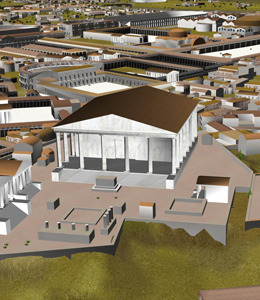Architecture

Digital rendering from Rome Reborn, of the Temple of Jupiter Optimus Maximus.
Elements of the model © 2008 The Regents of the University of California, © 2011 Université de Caen Basse-Normandie, © 2012 Frischer Consulting. All rights reserved. Image © 2012 Bernard Frischer

Reconstruction of Temple of Jupiter Optimus Maximus, John North Hopkins.
The original Temple of Jupiter Optimus Maximus was likely made of mud brick with stucco facing and cappellaccio foundations.1 There were three cellae, or temple chambers, one for Jupiter Optimus in the middle, one for Minerva on the right, and one for Juno Regina on the left.2 The cellae were likely not the full width of the podium.3 The original temple probably had dimensions around 53 x 63 meters.4 With little but foundations remaining, depicting what the Temple might have looked like is challenging.5 The Rome Reborn project provides one possibility (at left). Another reconstruction, by John North Hopkins (at left) describes a 74 x 54 meter foundation with a 4.85 meter tall podium, and a porch filled with columns.6 Filippo Coarelli suggests the Temple had colonnades on each side, six columns at the front of the Temple, and two more rows of columns between the façade and front walls of the cella.7 Although scholars still debate the Temple’s architecture, the most important element is the colossal size. The unprecedented size and scale of the Temple greatly contributed to its power as a cultural symbol for nearly one thousand years of Roman civilization.
1 L. Richardson, jr., A New Topographical Dictionary of Ancient Rome (Baltimore: the Johns Hopkins University Press, 1992), 222.
2 L. Richardson, jr., A New Topographical Dictionary of Ancient Rome (Baltimore: the Johns Hopkins University Press, 1992), 222; Filippo Coarelli, Rome and Environs: An Archaeological Guide (Berkeley: University of California Press, 2007), 33.
3 Filippo Coarelli, Rome and Environs: An Archaeological Guide (Berkeley: University of California Press, 2007), 33.
4 Filippo Coarelli, Rome and Environs: An Archaeological Guide (Berkeley: University of California Press, 2007), 33; John W. Stamper, The Architecture of Roman Temples (Cambridge: Cambridge University Press, 2005), 21-22.
5 Filippo Coarelli, Rome and Environs: An Archaeological Guide (Berkeley: University of California Press, 2007), 33.
6 John North Hopkins, The Genesis of Roman Architecture (New Haven: Yale University Press, 2016), 110-111.
7 Filippo Coarelli, Rome and Environs: An Archaeological Guide (Berkeley: University of California Press, 2007), 33.